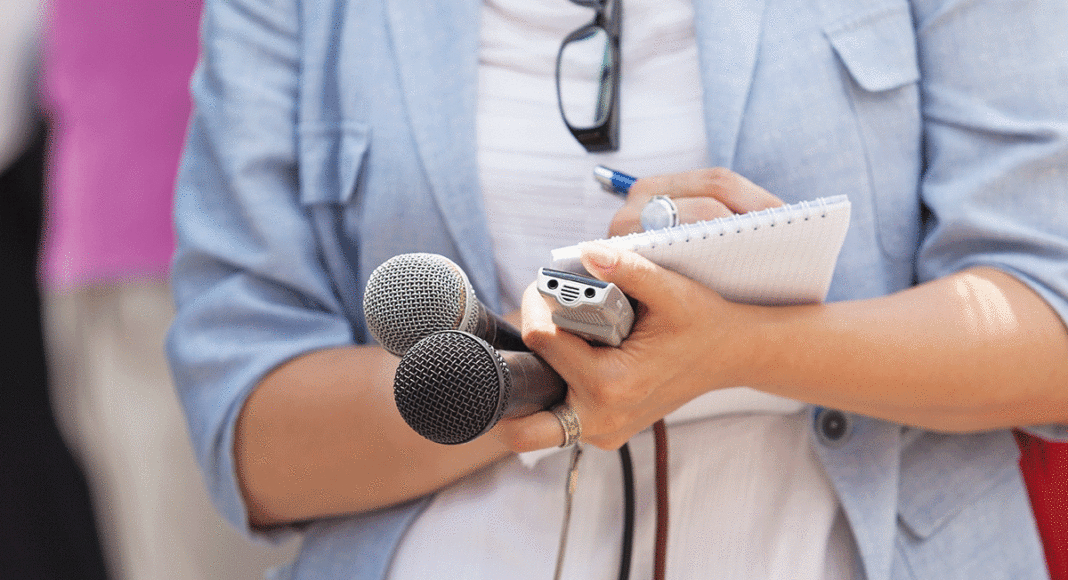Ryan Masters, a reporter for the Santa Cruz Sentinel, remembers it as “a nightmare situation.”
While he covered this month’s occupation at UCSC’s Kerr Hall, students repeatedly yelled, “Fuck you, Ryan Masters!” “Asshole!” and “Racist reporter!”
“The Afrikan/Black Student Alliance [A/BSA ]—I’ve got a lot of respect for them. I understand systemic racism. I understand white supremacy,” Masters says. “But unfortunately, with some things they say, they sound like a hate group.”
Masters had tried to get into the occupation by knocking on the door and asking to get into the building.
The A/BSA did not respond for comment for this story, but some students have said on social media that they felt the administrative building had been turned into a home for students. They say that by posting pictures, Masters was invading their privacy—although Masters responded that Kerr Hall is a public building. Students also criticized the way Masters wrote about a previous UCSC protest.
Some news outlets got more of a window into the occupation.
One day before the university acceded to protesters’ demands, A/BSA co-chair Imari Reynolds spoke on air with Tucker Carlson, who had just taken over Bill O’Reilly’s slot on Fox News. It struck Masters as an odd approach. “As far as them deciding the local news is the enemy and then going on Fox News, that just baffles me,” Masters says.
The protesters’ message may have been a little slow in getting out to the campus. One student told KSBW reporter Phil Gomez, “I tried reading news articles about it, and most of them said they wouldn’t talk to news crews, so I’m not entirely sure what that was all about.”
Masters says he saw people yelling at Gomez and KSBW cameraman Tom Lopez as well, although he took the brunt of the barrage himself—something the station’s news director Lawton Dodd agrees with, having followed the situation remotely.
“The protesters made it obvious that they weren’t going to talk to us. It was clear that Ryan was really the target of their ire,” Dodd says. “We cover the news, and if someone wants to talk, that’s part of the story. And if someone doesn’t want to talk—OK, that’s part of the story.”
One outlet, City on a Hill Press, UCSC’s student-run paper, did have reporters on the ground in Kerr Hall. In an editorial last week, the newspaper criticized local reporters for not showing more sensitivity in their coverage and for doing a lousy job building rapport with activists they cover.
If some people of color show distrust of how reporters represent them, a look at news trends nationwide might provide insight into why.
One study after another—conducted by researchers from institutions such as UC Santa Barbara and Yale—have found that news agencies skew their coverage, for instance, over-representing stories of African-Americans who are poor or involved in criminal activity. And a 2016 diversity census from the American Society of News Editors found that people of color made up 17 percent of newsroom journalists—an increase over previous years, but still nothing like the country as a whole.
Conn Hallinan, who taught journalism at UCSC for 23 years, says that—no matter the circumstances—it behooves activists to be open with reporters.
“The media is the way people access what’s going on in the world. As false as some of it may be, as controversial as some of it may be, it’s still the first line of communication,” says Hallinan, who was also provost for Kresge College for three years. “Even if you’re as critical of the media as I am, you have to talk to them and be confident that your protest is valid, that your demands are valid—that they reflect needs of students of color and the student population as a whole. There’s an old rule in politics that you don’t pick a fight with people who buy ink by the barrel.”
Hallinan, who once did 30 days in jail for a protest in 1963, stresses that he’s sympathetic to the struggles that people of color go through in this country. At the same time, he does not agree that protesters have any protection from being photographed.
On the other hand, he calls Masters’ decision to argue back-and-forth with people on Twitter “a dumb thing to do.”
We shouldn’t forget, of course, that the university did meet A/BSA’s demands, so the protesters didn’t really need any in-depth news coverage to achieve their stated goals.
Discussions around the First Amendment at schools isn’t unique to UCSC. In its controversial coverage of safe spaces, The Atlantic suggested in 2015 that some university activists have “weaponized the concept,” using safe spaces to shut down journalists.
Masters says, ultimately, his concern is that the press faces an assault—as he sees it—with intimidation coming from President Donald Trump on one side and some left-leaning protesters on the other.
Indeed, Americans’ trust in media has plummeted, beginning long before Trump took office, or even declared his candidacy. The portion of Americans who trust the news sank to 32 percent this past September, down from 55 percent in 1999 and a high of 72 percent in 1976, according to Gallup. The number dropped a whopping eight points between 2015 and 2016 alone.
But are protesters getting more standoffish with reporters than ever? Dodd, whose reporters spend a lot of time at breaking news scenes, says he’s hesitant to paint “in broad strokes”—looking for trends when they may or may not be there.
And although he doesn’t mind venting, Masters looks forward to putting the kerfuffle behind him.
“It upset me. It was interesting,” Masters says. “I don’t want to make a huge freaking deal about it because I don’t want to distract from the issues they’re talking about. That’s the story.”













